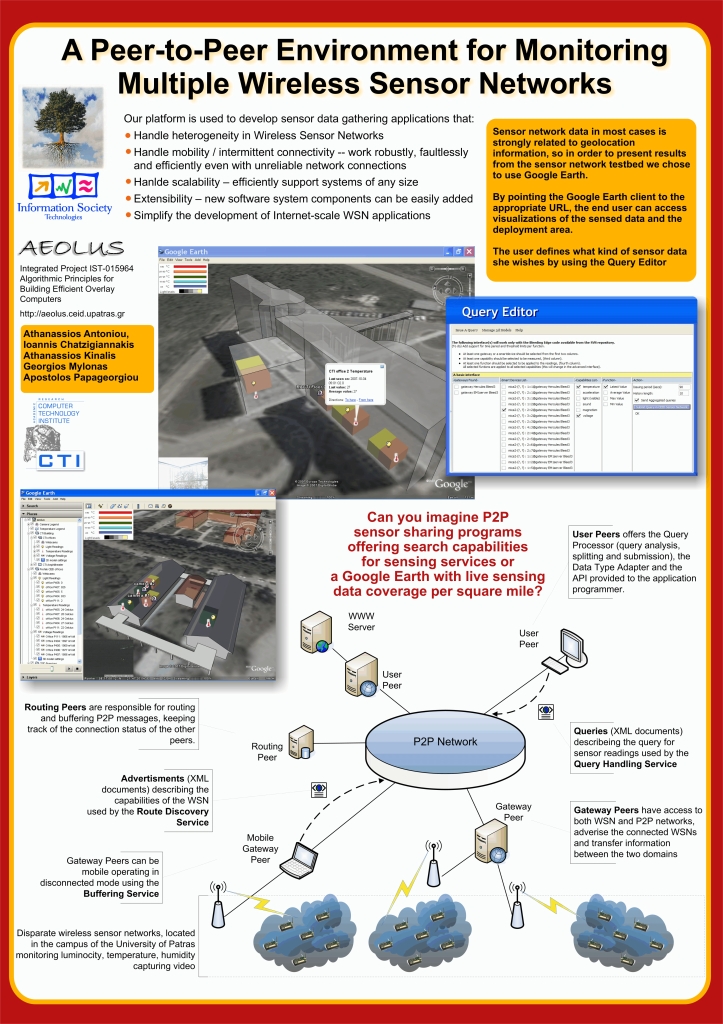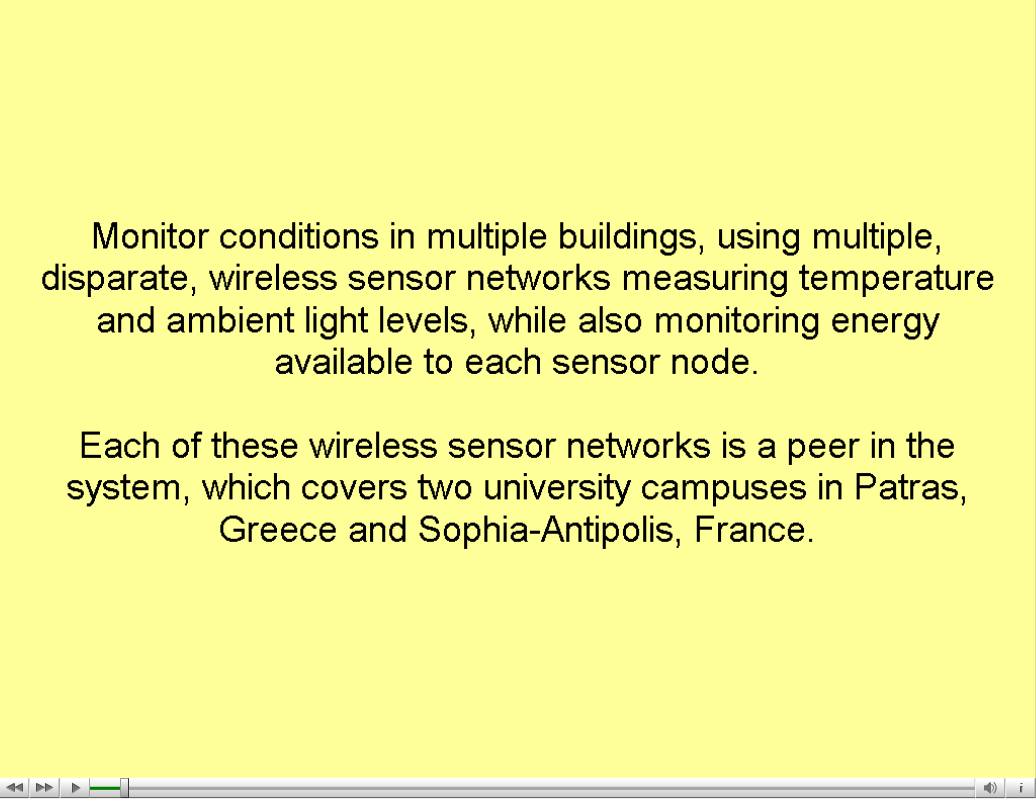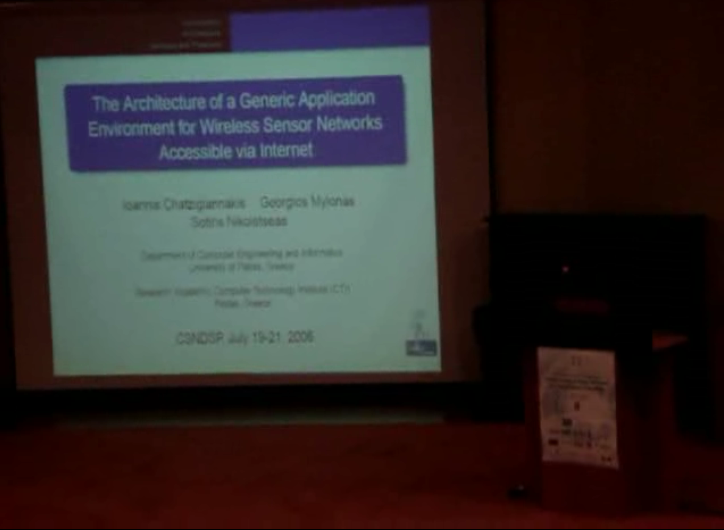| AEOLUS Demonstration |
|
This demonstration presents an application/system which deploying wireless sensor networks on top of an underlying web-based infrastructure aims at monitoring multiple buildings regarding several environmental parameters.
This particular WSN demo application/service is an outcome of out R&D work in the context of the EU FP6 Integrated Project AEOLUS: Algorithmic Principles for Building Efficient Overlay Computers (Contract No: 015964, Start date: 1/9/2005, End date: 31/8/2009) and incorporates part of the theoretical and experimental study, investigations and findings obtained through the first 2.5 years of the project. In particular, there are deployed multiple wireless networks of autonomous tiny devices of different technologies (mica2, telosB, SUN SPOT) that monitor the luminosity, temperature, humidity of their environment and capture video in several geographic areas. It is also deployed an additional sensor network in the area of the ICT exhibition. Possible applications of such networks include building monitoring, energy saving, security etc. These WSNs are part of the heterogeneous AEOLUS overlay computer platform - all interconnected via Internet - and are able to provide their services through it. Users can have access to these WSNs and the corresponding services through Google Earth, a very popular web-based GIS application while a 3-dimensional user-interface particularly developed for our WSN-based service has been used for the visualization of the whole process. Of course, sensing, managing and visualizing environmental parameters is only an attractive subset of services that could be supported by embedding wireless network components into an internet-connected overlay computer. Visitors are able to interact with the demonstration by acquiring and obtaining in real time live-sensed data at any desired part of the network (through Google Earth). In addition, several sensor devices will be available at the exhibition room offering visitors the opportunity to physically interact with them, by moving them around for instance, and watch relevant impacts (i.e., changes in temperature, luminosity, etc) live in a 3-dimensional space. The demonstration is supported by posters and leaflets which explain objectives of the demonstrated applications and provide insight for more fundamental and technical details of their implementation, as well, in a simple and easy-to-understand way. Apart from its R&D significance and its practical extensions (since if properly adapted our application could be actually used in practice), this system targets a wide audience which may range from specialists to everyday people/users aiming to show the vision on what can be achieved through the exploitation of a heterogeneous (wired and wireless), internet-based environment and how embedding wireless network components made of simple, tiny sensor devices into an internet-connected overlay computer can enhance in several aspects everyday life. Additional Material
The Visitors Experience Visitors experience in real time how simple WSNs made of tiny sensor devices and connected to an internet-based, heterogeneous network environment can be used for collecting, transmitting, managing and observing several important environmental parameters within a highly distributed geographical area. Visitors see how tiny sensors, with limited computational and power capabilities can cooperate to accomplish tasks that are difficult or beyond the capabilities of today’s conventional centralized systems. Visitors see the deployed network consisting of those small high-tech devices along with its 3D Google Earth-based representation, they are shown how such a network globally available through the Internet can be used, they actually watch on monitors the visualization of all collected information and how it is used to monitor the environmental conditions of several geographical areas and hopefully realize the scientific and technical potential as well as several possible extensions such an application can have. Finally, visitors can have the opportunity to actually hold the sensor devices, move them around and watch in real time the movement representation via Google Earth through certain ways such as animation. For visitors to get familiar with the services that can be achieved through the exploitation of a heterogeneous, internet-based environment of wireless network components made of small sensor devices, this demonstration contains strong visual aspects: the deployment of a WSN out of a large number of tiny devices that sense the environment in discrete geographical areas and communicate in a wireless manner using an underlying internet-connected overlay computer has been combined with a user-friendly, graphical representation/visualization of the sensor network in a web application deployed in the three-dimensional space with the use of Google Earth. In addition, this demonstration can well attract and captivate the interest of visitors who are able to capture, check and see in 3D space the status of environmental parameters inside the exhibition room, or in some other point of the network or even inside their hands since they will be encouraged to keep the tiny sensors and move them around in the exhibition room. This “real-time” interaction of visitors with this system but also with the tiny sensors themselves certainly make the exhibit appealing to the audience. Furthermore, visitors that would like to take a step behind colors and animations are able to easily but correctly gain an insight in more technical background details regarding the application by just taking a look at the supporting material (posters, leaflets, on-screen information, etc). The innovation of this technology The system constitutes an implementation of a part of what we call the “internet of things”. It uses heterogeneous small devices of limited sensing, signal processing, communication and power capabilities to build large societies that are interconnected to accomplish tasks that are difficult for conventional centralized systems. The result is the creation of a globally available computing machine that makes use of the capabilities of these internet-connected societies. The use of Google Earth as an interface is also innovative, and is used as a means to showcase potential sensor network applications. The AEOLUS Project This demonstration is based on work that has been carried out in the context of our EU FP6 Integrated Project AEOLUS: Algorithmic Principles for Building Efficient Overlay Computer and incorporates part of the theoretical and experimental study, investigations and findings obtained through the first 2.5 years of the project. AEOLUS is one of the three projects supported by EU within the Global Computing II Initiative. Our motivations have stemmed from the fact that the recent explosive growth of the Internet gives rise to the possibility of a global computer of grand-scale consisting of heterogeneous Internet-connected computing entities, globally available and able to provide to its users a rich menu of high-level integrated services that make use of its aggregated computational power, storage space, and information resources. Achieving this efficiently and transparently is a major challenge that can be overcome by introducing an intermediate layer, the overlay computer. The goal of AEOLUS is to investigate the principles and develop the algorithmic methods for building such an overlay computer that enables this efficient and transparent access to the resources of an Internet-based global computer.A wide range of important theoretical and experimental findings/results obtained till now within AEOLUS addressing all these challenges make AEOLUS a successful ongoing European project and certainly imply its successful continuation and completion.
|




